Russian diaspora
The Russian diaspora is the global community of ethnic Russians. The Russian-speaking (Russophone) diaspora are the people for whom Russian language is the native language, regardless of whether they are ethnic Russians or, for example, Belarusians, Tatars, or Jews.
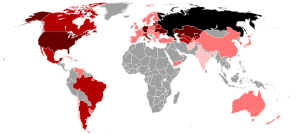
The number of ethnic Russians living outside the Russian Federation is estimated at roughly between 20 and 30 million people (depending on the notion of "ethnicity" used), the majority of them in countries of the Former Soviet Union; about 30 million native speakers of Russian are estimated to live outside the Russian Federation (compared to 147 million living within the Russian Federation).[1]
The largest overseas community is found in the United States, estimated at some 3.1 million people. The next largest communities of Russian speakers outside the former Soviet Union are found in Germany and in Israel, both of unknown size but estimated at around 1.2 million people in Germany and around 1,000,000 in Israel. In addition, in Canada, Australia, Argentina, Brazil, The United Kingdom, New Zealand, Paraguay and Venezuela, several hundred thousand citizens each identify as being of at least partial Russian descent.
History
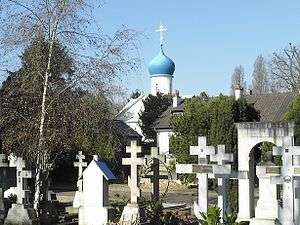
A significant ethnic Russian emigration took place in the wake of the Old Believer schism in the 17th century (for example, the Lipovans, who migrated southwards around 1700). Later ethnic Russian communities, such as the Doukhobors (who emigrated to the Transcaucasus from 1841 and onwards to Canada from 1899), also emigrated as religious dissidents fleeing centrist authority.
Emigration from the USSR is often broken down into three "waves" (волны) of emigration. The waves are the "First Wave", or "White Wave", which left during the Communist Revolution of 1917 and the following civil war, the "Second Wave" which emigrated during and after World War Two, and the "Third Wave", which emigrated throughout the 1950s, 1960s, 1970s, and 1980s.
A sizable wave of ethnic Russians emigrated in the wake of the October Revolution of 1917 and Civil War of 1917-1922. They became known collectively as the White émigrés. This emigration is also referred to as the "first wave", even though previous emigrations had taken place, as it was comprised the first emigrants to have left in the wake of the communist revolution, and because it exhibited a heavily political character.
A smaller group of Russians, often referred to by Russians as the "second wave" of Russian emigration, left during World War II. They were refugees, Soviet POWs, eastern workers, or surviving veterans of the Russian Liberation Army and other anti-communist armed units who had served under the German command and evaded forced repatriation. In the immediate postwar period, the largest Russian communities in the emigration settled in Germany, Canada, the U.S., United Kingdom and Australia.
Emigres who left after the death of Stalin, but before perestroika, are often grouped into a "third wave". These emigres were mostly Jews, Armenians, Germans, and other peoples who resided outside the former borders of the Russian Empire but now found themselves inside the borders of the USSR. This majority of this wave left during the 1970s.
At the beginning of the 1990s, Russia experienced one of the most dramatic periods in its history; as a result, the former administrative SFSR of the Soviet Union became a separate sovereign state. The collapse of the USSR resulted in an upsurge of international migrations to Russia, and the overwhelming number of them involve population movements between Russia and other post-Soviet states.[2]
Statistics
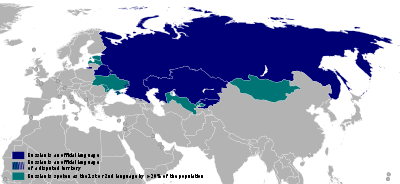
Some 20 to 30 million ethnic Russians are estimated to live outside the bounds of the Russian Federation (depending on the definition of "ethnicity"). Official census data often only considers nationality. The number of native speakers of the Russian language who reside outside of the Russian Federation is estimated as close to 30 million by SIL Ethnologue.[3]
- In the Former Soviet Union
| Country | ethnic Russians |
|---|---|
| 8,300,000 (2001)[4] | |
| 3,619,002 (2017)[5] | |
| 640,000 | |
| 800,000[6] | |
| 400,000[7][8] | |
| 570,000[9] | |
| 370,000 (2004)[10] | |
| 310,000[11] | |
| 300,000[12] | |
| 180,000[13] | |
| 140,000[14][15] | |
| 68,200[16] | |
| 26,586[17][18] | |
| 11,911[19] | |
- Former Warsaw Pact
| Country | ethnic Russians |
|---|---|
| 30,000[20] | |
| 15,595[21] | |
| 13,000[22] |
- Outside of the former Soviet Union or Warsaw Pact
| Country | ethnic Russians |
|---|---|
| 3,100,000[23] | |
| 1,213,000[24] | |
| 1,000,000[25] | |
| 550,520[26] | |
| 200,000 to 500,000 [27] | |
| 350,000 [28] | |
| 340,000[29] | |
| 120,000 (2006)[30] | |
| 78,400 (2015)[31] | |
| 70,927 (2016)[32] | |
| 67,550[33] | |
| 56,600[34] | |
| 50,200[34] | |
| 35,000 (2013)[35] | |
| 34,600[36] | |
| 30,249[37] | |
| 20,930[38] | |
| 20,000[39] | |
| 15,600[40] | |
| 5,000[41] | |
| 13,914[42] | |
| 10,235[43] | |
| 5,000[44] | |
| 3,290[45] | |
Former USSR
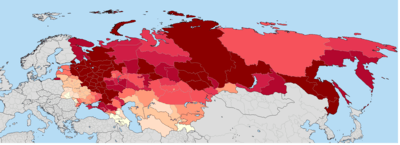
Today the largest ethnic Russian diasporas outside of Russia exist in former Soviet states such as Ukraine (about 8 million), Kazakhstan (3,644,529 / 20.61%) 2016[46], Belarus (about 1.2 million), Latvia (about 620,000), Uzbekistan (about 650, 000)[47] and Kyrgyzstan (about 600,000).[48]
The situation faced by ethnic Russian diasporas varied widely. In Belarus there was no perceivable change in status. While in Estonia and Latvia[49] they were labelled foreigners or non-citizens if none of their ancestors had been a citizen of these countries before Soviet occupation and if they did not request Russian Federation citizenship during the period it was available.
East Asia and Southeast Asia
Russians (eluosizu) are one of the 56 ethnic groups officially recognized by the People's Republic of China. There are approximately 15,600, living mostly in northern Xinjiang, and also in Inner Mongolia and Heilongjiang. In the 1920s Harbin was flooded with 100,000 to 200,000 Russian White émigrés fleeing from Russia. Some Harbin Russians moved to other cities such as Shanghai, Beijing, and Tianjin. By the 1930s, Shanghai's Russian community had grown to more than 25,000.[50]
There are also smaller numbers of Russians in Japan and in Korea. The Japanese government disputes Russia's claim to the Kuril Islands, which were annexed by the USSR in 1945 after Japan's surrender in World War II. The Red Army expelled all Japanese from the island chain, which was resettled by Russians and other Soviet nationalities. A few Russians also settled in the Korean peninsula in the late 19th and early 20th centuries.[51] The population of Russians in Singapore was estimated at no more than a thousand by the local Russian embassy in 2008; they are a largely professional and business-oriented expatriate community, and count among their numbers more than a hundred company owners or local heads of branches of large Russian multinationals.[52]
Americas
Russian settlement in Mexico was minimal but well documented in the 19th and early 20th centuries. A few breakaway sectarians from the Russian Orthodox Church, partial tribes of Spiritual Christian Pryguny arrived in Los Angeles beginning in 1904 to escape persecution from Tsarist Russia, and were diverted to purchase and colonize land in the Guadalupe Valley northeast of Ensenada to establish a few villages and where they maintained their Russian culture for a few decades before they were abandoned; cemeteries bearing Cyrillic letters remain. Dissenters of the official Soviet Communist party like the Trotskyites along with leader Leon Trotsky found refuge in Mexico in the 1930s, where Trotsky himself was assassinated by Ramon Mercader in 1940.
Some Ukrainian Americans, Belarusian Americans, Russian-speaking Jewish Americans, Russian-speaking German Americans, Georgian Americans, Azerbaijani Americans, Armenian Americans, and Rusyn Americans identify as Russian American.
Other
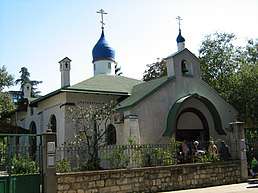
Finland borders Russia directly (Finland was an autonomous Russian Grand Duchy between 1809 and 1917, but not part of the Soviet Union, which came about in 1922) and has 31,000 Russian Federation citizens, which amounts to 0.56% of the population,[53] and 80,000 (1.5%) speak Russian language as their mother tongue.
See also
- Russian language in post-Soviet states
References
- native speakers of Russian do not necessarily identify as ethnically Russian; notably, in Ukraine, 5.5 million native speakers of Russian self-identified as ethnic Ukrainians in the 2000 census (see demographics of Ukraine); in Israel, up to a million Russian speakers may or may not identify as "ethnic Russians" on top of self-identification as Jewish.
- Uma A. Segal Professor of Social Work University of Missouri; Doreen Elliott Professor of Social Work University of Texas at Arlington; Nazneen S. Mayadas Professor Emerita University of Texas at Arlington (13 December 2009). Immigration Worldwide : Policies, Practices, and Trends: Policies, Practices, and Trends. Oxford University Press. p. 47. ISBN 978-0-19-974167-0. Retrieved 1 September 2013.
- reporting 137 million native speakers within the Russian federation as of 2010, out of 167 million native speakers worldwide. Lewis, M. Paul, Gary F. Simons, and Charles D. Fennig (eds.). 2014. Ethnologue: Languages of the World, Seventeenth edition. Dallas, Texas: SIL International
- out of 8.3 million Ukrainian residents who identified as ethnic Russians, 0.3 million identified Ukrainian as their primary language; conversely, out of 37.5 million who identified as ethnic Ukrainians, 5.5 million identified Russian as their primary language. (2001 census) Archived 2006-11-26 at the Wayback Machine
- "Численность населения РК по отдельным этносам 2017г". Stat.gov.kz. Retrieved 11 January 2018.
- CIA Factbook in 2014 estimates 8.3% ethnic Russians out of a population of 9.61 million.
- "Демографические тенденции, формирование наций и межэтнические отношения в Киргизии". Demoscope.ru. Retrieved 5 April 2015.
- "The World Factbook". Cia.gov. Retrieved 5 April 2015.
- CIA Factbook in 2014 estimates 26.2% ethnic Russians out of a population of 2.16 million.
- 369,896 or 9.39% of total population according to the 2004 census Archived 2007-11-24 at the Wayback Machine
- CIA Factbook in 2014 estimates 24.8% ethnic Russians out of a population of 1.26 million. (2013)
- "Turkmen pledge on Russian rights". News.bbc.co.uk. 9 July 2003. Retrieved 11 January 2018.
- 5.8% of the total population according to the Lithuanian census of 2011.
- "The World Factbook". Cia.gov. Retrieved 5 April 2015.
- "Southern Caucasus: Facing Integration Problems, Ethnic Russians Long For Better Life". EurasiaNet.org. Retrieved 5 April 2015.
- "Итоги переписи населения Таджикистана 2000 года: национальный, возрастной, половой, семейный и образовательный составы". Demoscope.ru. Retrieved 5 April 2015.
- "Population Census 2014" (PDF). geostat.ge. Retrieved 5 June 2018.
- Georgia: Ethnic Russians Feel Insulated From Tensions, Radio Free Europe
- "(2002 census)" (PDF). Docs.armstat.am. Retrieved 11 January 2018.
- "Informatii utile - Agentia Nationala pentru Intreprinderi Mici si Mijlocii". Mimmc.ro. Archived from the original on 13 May 2007. Retrieved 11 January 2018.
- "National Statistical Institute". Nsi.bg. Retrieved 5 April 2015.
- "Polish Statistics" (PDF). Stat.gov.pl. 2011. ISBN 978-83-7027-521-1. Retrieved 11 January 2018.
- self-reported ethnicity as of 2007; 0.4 million Russian-born.
- "Russian migrants residing in Germany—this includes current and former citizens of the Russian Federation as well as former citizens of the Soviet Union". Destatis.de. Retrieved 11 January 2018.
- "Monthly Bulletin of Statistics". Cbs.gov.il. Retrieved 2011-03-22.
- self-reported ethnic origin as of 2011; 107,300 gave Russian as single ethnic origin; an additional 443,220 gave Russian as one of several ethnic origins im "multiple ethnic origins responses".
- "La communauté russe en France est "éclectique"". Russieingo.com. Retrieved 5 April 2015.
- ://www.lanacion.com.ar/sociedad/por-que-hay-tantos-rusos-argentina-tan-nid2248366
- "Wayback Machine". Web.archive.org. 28 September 2007. Archived from the original on 28 September 2007. Retrieved 11 January 2018.
- "Statistiche demografiche ISTAT". Demo.istat.it. Retrieved 11 January 2018.
- http://www.stat.fi/tup/suoluk/suoluk_vaesto_en.html
- "Foreign population by nationality, provinces, sex and year". Instituto Nacional de Estadística. Spain's National Institute of Statistics. 2017. Retrieved 12 December 2017.
Search ("consultar selección") by "Nacionalidad" = "Rusia", "Provincias" = "TOTAL ESPAÑA", "Sexo" = "Ambos sexos" (both sexes) and "Año" = Your year of choice.
- "Australian Bureau of Statistics". Abs.gov.au. Retrieved 5 April 2015.
- "Créditos". Cubagob.cu. Retrieved 5 April 2015.
- "Nationality and country of birth by age, sex and qualifications Jan - Dec 2013 (Excel sheet 60Kb)". Ons.gov.uk. Office for National Statistics. Retrieved 11 June 2014.. 35,000 Russian nationals and 39,000 Russian-born residents estimated for 2013 (based on 2011 data).
- Joshua Project. "Country - Venezuela". Joshuaproject.net. Retrieved 5 April 2015.
- Statistik Austria. "STATISTIK AUSTRIA - Bevölkerung nach Staatsangehörigkeit und Geburtsland". Statistik.at. Retrieved 5 April 2015.
- "Folkmängd efter födelseland 1900–2017" (in Swedish). Statistics Sweden. Retrieved 21 February 2018.
- Belgian residents from the ex-USSR countries that resided in Belgium in 2008: 21,655. An estimate of 50,000 was given by diaspora organisation russian-belgium.be, based on extrapolation of naturalization data, online polls among their members, and a loose definition of "Russian" as anyone who has been exposed to the Soviet education system or who speaks Russian.
- "Archived copy". Archived from the original on 2007-09-28. Retrieved 2006-12-17.CS1 maint: archived copy as title (link)
- "坦言集:俄羅斯在港 - 東方日報". orientaldaily.on.cc. Retrieved 11 January 2018.
- "Statistics Norway". Ssb.no. Retrieved 11 January 2018.
- "3. Facts and figures – Russians, Ukrainians and Baltic peoples – Te Ara Encyclopedia of New Zealand". Teara.govt.nz. Retrieved 5 April 2015.
- "Qatar's population - by nationality". bq Magazine. Archived from the original on 22 December 2013. Retrieved 5 April 2015.
- "Миграциони профил Републике Србије за 2013. годину" (PDF). Kirs.gov.rs. Retrieved 11 January 2018.
- "Численность населения Республики Казахстан по отдельным этносам на начало 2016 года". Stat.gov.kz. Retrieved 11 January 2018.
- Uzbekistan: People: Ethnic Groups. World Factbook of CIA
- John Pike. "KYRGYZSTAN: Economic disparities driving inter-ethnic conflict". Globalsecurity.org. Retrieved 5 April 2015.
- "Russians beyond the Limits of Russia", O.I. Vendina, Geography newspaper, no. 11, 2001 (in Russian)
- "Tales of Old Shanghai - cultures - Russians". Talesofoldchina.com. Archived from the original on 28 September 2007. Retrieved 11 January 2018.
- Clark, Donald N. (1994), "Vanished Exiles: The Prewar Russian Community in Korea", in Dae-Sook Suh (ed.), Korean Studies: New Pacific Currents, University of Hawaii Press, pp. 41–58, ISBN 0-8248-1598-X
- Drankina, Yekaterina (2008-03-10), "Сингапурский десант", Kommersant Den'gi, 9 (664), retrieved 2009-07-30
- Tilastokeskus: Ulkomaiden kansalaiset (Statistics Finland: Foreign Citizenship) in Finnish, 2013
External links
- Russia Abroad: A comprehensive guide to Russian Emigration after 1917 Biographical databases. Photoarchive. Research results accompanied by original documents, paper extracts.
- Largest Russian-Ukrainian settlement support network outside of xUSSR - 300.000 members
| Wikimedia Commons has media related to Russian diaspora. |